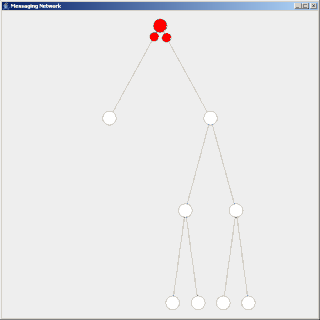External links
- IETF Draft The latest draft specification published by the IETF
- Original publication The first paper presenting ODMRP.
In wireless networking, On-Demand Multicast Routing Protocol is a protocol for routing multicast and unicast traffic throughout Ad hoc wireless mesh networks.
ODMRP creates routes on demand, rather than proactively creating routes as OLSR does. This suffers from a route acquisition delay, although it helps reduce network traffic in general. To help reduce the problem of this delay, some implementations send the first data packet along with the route discovery packet.
Because some links may be asymmetric, the path from one node to another is not necessarily the same as the reverse path of these nodes.
Multiprotocol Label Switching (MPLS) is a routing technique in telecommunications networks that directs data from one node to the next based on labels rather than network addresses. Whereas network addresses identify endpoints the labels identify established paths between endpoints. MPLS can encapsulate packets of various network protocols, hence the multiprotocol component of the name. MPLS supports a range of access technologies, including T1/E1, ATM, Frame Relay, and DSL.

A wireless mesh network (WMN) is a communications network made up of radio nodes organized in a mesh topology. It can also be a form of wireless ad hoc network.

The Optimized Link State Routing Protocol (OLSR) is an IP routing protocol optimized for mobile ad hoc networks, which can also be used on other wireless ad hoc networks. OLSR is a proactive link-state routing protocol, which uses hello and topology control (TC) messages to discover and then disseminate link state information throughout the mobile ad hoc network. Individual nodes use this topology information to compute next hop destinations for all nodes in the network using shortest hop forwarding paths.
Dynamic Source Routing (DSR) is a routing protocol for wireless mesh networks. It is similar to AODV in that it forms a route on-demand when a transmitting node requests one. However, it uses source routing instead of relying on the routing table at each intermediate device.
IP multicast is a method of sending Internet Protocol (IP) datagrams to a group of interested receivers in a single transmission. It is the IP-specific form of multicast and is used for streaming media and other network applications. It uses specially reserved multicast address blocks in IPv4 and IPv6.
Delay-tolerant networking (DTN) is an approach to computer network architecture that seeks to address the technical issues in heterogeneous networks that may lack continuous network connectivity. Examples of such networks are those operating in mobile or extreme terrestrial environments, or planned networks in space.

Flooding is used in computer networks routing algorithm in which every incoming packet is sent through every outgoing link except the one it arrived on.
The Multicast MAnet Routing Protocol (MMARP) aims to provide multicast routing in Mobile Ad Hoc Networks (MANETs) taking into account interoperation with fixed IP networks with support of IGMP/MLD protocol. This is achieved by the Multicast Internet Gateway (MIG) which is an ad hoc node itself and is responsible for notifying access routers about the interest revealed by common ad hoc nodes. Any of these nodes may become a MIG at any time but needs to be one hop away from the network access router. Once it self-configures as MIG it should then broadcast periodically its address as being the one of the default multicast gateway. Whoever besides this proactive advertisement the protocol states a reactive component the ad hoc mesh is created and maintained.
6LoWPAN is an acronym of IPv6 over Low-Power Wireless Personal Area Networks. 6LoWPAN is the name of a concluded working group in the Internet area of the IETF.
A wireless ad hoc network (WANET) or mobile ad hoc network (MANET) is a decentralized type of wireless network. The network is ad hoc because it does not rely on a pre-existing infrastructure, such as routers in wired networks or access points in wireless networks. Instead, each node participates in routing by forwarding data for other nodes, so the determination of which nodes forward data is made dynamically on the basis of network connectivity and the routing algorithm in use.

The Better Approach to Mobile Ad-hoc Networking (B.A.T.M.A.N.) is a routing protocol for multi-hop mobile ad hoc networks which is under development by the German "Freifunk" community and intended to replace the Optimized Link State Routing Protocol (OLSR).
In multi-hop networks, Adaptive Quality of Service routing protocols have become increasingly popular and have numerous applications. One application in which it may be useful is in Mobile ad hoc networking (MANET).
In packet switching networks, traffic flow, packet flow or network flow is a sequence of packets from a source computer to a destination, which may be another host, a multicast group, or a broadcast domain. RFC 2722 defines traffic flow as "an artificial logical equivalent to a call or connection." RFC 3697 defines traffic flow as "a sequence of packets sent from a particular source to a particular unicast, anycast, or multicast destination that the source desires to label as a flow. A flow could consist of all packets in a specific transport connection or a media stream. However, a flow is not necessarily 1:1 mapped to a transport connection." Flow is also defined in RFC 3917 as "a set of IP packets passing an observation point in the network during a certain time interval." Packet flow temporal efficiency can be affected by one-way delay (OWD) that is described as a combination of the following components:
Shortest Path Bridging (SPB), specified in the IEEE 802.1aq standard, is a computer networking technology intended to simplify the creation and configuration of networks, while enabling multipath routing.

The Babel routing protocol is a distance-vector routing protocol for Internet Protocol packet-switched networks that is designed to be robust and efficient on both wireless mesh networks and wired networks. Babel is described in RFC 8966.
IEEE 802.11s is a wireless local area network (WLAN) standard and an IEEE 802.11 amendment for mesh networking, defining how wireless devices can interconnect to create a wireless LAN mesh network, which may be used for relatively fixed topologies and wireless ad hoc networks. The IEEE 802.11s task group drew upon volunteers from university and industry to provide specifications and possible design solutions for wireless mesh networking. As a standard, the document was iterated and revised many times prior to finalization.
Associativity-based routing is a mobile routing protocol invented for wireless ad hoc networks, also known as mobile ad hoc networks (MANETs) and wireless mesh networks. ABR was invented in 1993, filed for a U.S. patent in 1996, and granted the patent in 1999. ABR was invented by Chai Keong Toh while doing his Ph.D. at Cambridge University.
CBRP, or Cluster Based Routing Protocol, is a routing protocol for wireless mesh networks. CBRP was originally designed in mid 1998 by the National University of Singapore and subsequently published as an Internet Draft in August 1998. CBRP is one of the earlier hierarchical ad-hoc routing protocols. In CBRP, nodes dynamically form clusters to maintain structural routing support and to minimize excessive discovery traffic typical for ad-hoc routing.
Deterministic Networking (DetNet) is an effort by the IETF DetNet Working Group to study implementation of deterministic data paths for real-time applications with extremely low data loss rates, packet delay variation (jitter), and bounded latency, such as audio and video streaming, industrial automation, and vehicle control.